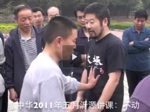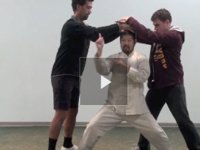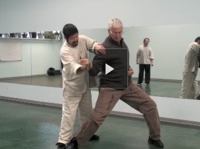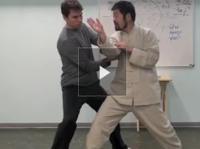A clip from the Ireland 2010 workshop.
Knowledge : Principle-Technical
Taiji movement is similar to movement of the umbrella top, which is controlled by the ring around its handle.
Videos below.
 One concept which seems to come up in almost every lesson and principle Master Chen teaches is connection. But what does “being connected” actually mean? How do we achieve it and what are the benefits of being connected? I think these are all important questions that any serious Chen Style Taijichuan Practical Method student needs to explore and understand in order to gain a deeper understanding of this complex art. While most practioners seem to focus on the external choreography of the art, which is the first step and the foundation of the Yilu, I think the answer to what connection is can only be found by focusing on what happens inside the body. Taiji is, after all, an internal martial art!
One concept which seems to come up in almost every lesson and principle Master Chen teaches is connection. But what does “being connected” actually mean? How do we achieve it and what are the benefits of being connected? I think these are all important questions that any serious Chen Style Taijichuan Practical Method student needs to explore and understand in order to gain a deeper understanding of this complex art. While most practioners seem to focus on the external choreography of the art, which is the first step and the foundation of the Yilu, I think the answer to what connection is can only be found by focusing on what happens inside the body. Taiji is, after all, an internal martial art!
Clip from Suspended Head Mini Lesson
“Don’t Move: Chen Zhonghua Lecture at the 2011 Daqingshan Hong Junsheng Taijiquan International Conference and Competition” Online Video Trailer 3

Master Chen Zhonghua’s teaching recording on the principle of not moving the body while doing taiji. This is part of his lectures to the full time students on Daqingshan during the 2011 Daqingshan Hong Junsheng Taijiquan International Conference and Competition. Author: Chen Zhonghua Length: 52 min. In: Chinese Year: 2011 Difficulty:3/5 At:Daqingshan Mountain Resort for Taiji
Rotate Like Wheel Axis is the original concept that describes the rotation used in taijiquan. It is imperative that this analogy not changed to something else. The continued and deepened understanding of this technical principle will bring about real understanding of taiji.
Clip from Yilu Correction Collection
Fixed Hand. Having the hand fixed in relation to the wrist is one of the most important technical principles of Chen Style Taijiquan Practical Method system. Only when the hand is relatively fixed, all other actions will start.
Clip from Yilu Correction Collection
Maintain Energy: While moving, one must maintain energy throughout the moves such as executing a taiji technique or doing the routine. This is another Chen Style Taijiquan Practical Method principle.
Clip from Yilu Correction Collection

Two Sticks: refers to the two part alignment of the body, which is part of the three-direction energy alignment of the Chen Style Taijiquan Practical Method system.
In this video, there are 15 Minutes of explanations and applications of the two sticks in the body in tai chi chuan practice by Master Chen Zhonghua Author: Chen Zhonghua Length: 15 min. In: English Year: 2011 Difficulty:4/5 At:Maple Ridge, B.C. Canada
This clip is from the New York 2011 Private Workshop
In this clip, Master Chen shows the intricacies of the transition moves between 12 (The Fist of Covering Hand) and 13 (Buddha’s Warrior Attendant Pounds Mortar).
“In the form it is slow but in usage it is much faster.” Read more

This lesson covers a foundation Taiji principle of Yin/Yang separation by opening the joints to generate power. Key words: normal / trained inside / outside differentiation. Two lines of energy. Author: Chen Zhonghua Length: 13 min. In: English Year: 2010 Difficulty:2/5 At:Edmonton

Suspended head is a taiji concept that refers to the state of the spine line being erect at all times. When done right, the head is always suspended like being pulled from above or having something underneath it that provides support.
Contents: 1. Introduction. 2. What is suspended head? 3. How does not work? 4. Connected. 5. Test it out. 6. Conclusion. Author: Chen ZhongHua Length: 21 min. In: English Year: 2010 Difficulty:3/5 At:Edmonton

Concepts covered in this 32-minute video: 1. Three Way Split. 2. How to be continuous and don’t stop the momentum. 3. How the three way split functions and enhances fajin skill. 4. How to find the point to fajin from. 5. How to find the one point to fajin to. 6. Lever point. 7. Demarcation line.
Author: Chen ZhongHua Length: 32 min. In: English Year: 2010 Difficulty:4/5 At:Edmonton
I was recently looking through some old notes and came across Master Chen Zhonghua’s “New Theory on the Eight Methods.” It is also known as the eight techniques. I thought this might be of interest due to the recent discussion of the Eight Methods mentioned in Rion’s notes from the Cannon Fist workshop. Read more
July 11, 2010
Every move in Taiji is a downward move. This begs the question how many moves can you make before you are sitting on the floor? Master Chen says if you can make every move a downward move without going down then you have got it. The key is that downward is a rotation. This rotation is called sinking.
I watched the Toronto Workshop 3-4 video today. I got a different understanding on the material presented. Although I was there at the workshop, I didn’t really understand much at the time as I was so new to Taiji. I had no clue on many of the concepts.
2008陈式洪派培训班—李老师讲解正反旋圈要点
At a higher level, stretching moves are changed to arching moves. Arching is really a way of extension without stopping the energy flow.Arching is more stable than stretching. However, arching creates less distance than stretching.
Some examples:
- When moving the arm back towards your body, don’t allow your front knee to move backwards. This way, you can extend your foot hand arching length.
- When pushing the front arm out, don’t allow your rear knee to move forward. This will make your rear foot-front arm stretch longer.
One of the characteristics of the Chen Style Taijiquan Practical Method System is the technique to bounce the opponent out. In this short video clip, Master Chen Zhonghua taught Nicholas Fung and Alex Nay to follow a simple procedure to start the bouncing sequence:
- Make sure that you make contact with your opponent.
- Always back off a bit so that you can feel you have absorbed your opponent’s power.
- Anchor you rear foot, or whichever foot is the farthest from your opponent. This is a two way lock. It cannot move sideways, or backwards.
- Lock your hand/hands onto your target. It is the same lock as your foot except the foot is locked onto the floor while the hand is locked onto your opponent.
- Make sure that you wiggle your hands a little bit so that they aim at your opponent’s center.
- Now move your waist. This move will create a tension that bounces your opponent out. This move is very much like the pull on the string of the bow as in using a bow and arrow.
Here is a clip that shows how to use the energy on the outside of your body to counter.



